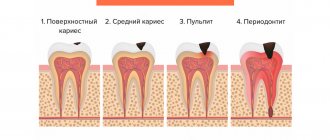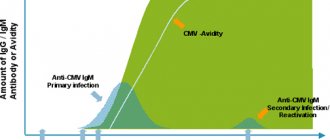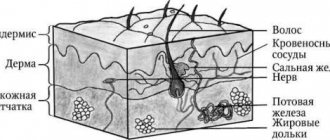Melanoma is one of several dozen malignant skin tumors, and at the same time one of the most aggressive.
Data from the National Cancer Registry shows that melanoma is increasingly common in young people ages 24-40, especially women. Every year, several thousand patients in Russia find out that they have melanoma.
If you notice pigment changes on the skin - the appearance or change in the color and shape of moles, be sure to check with a dermatologist.
Melanoma, what is it?
Melanocytes synthesize pigments responsible for coloring the skin, eye color, and hair. Pigmented formations filled with melanin are called moles and can appear throughout life. Certain causative factors of an exogenous (from the Greek “exo” - external) and endogenous (“endo” - internal) nature can cause malignancy of nevi. As a result, areas of the body where there are congenital or acquired nevi are at risk of developing melanoma: the skin, less often the mucous membranes and the retina. The altered cells are able to multiply and grow uncontrollably, forming a tumor and metastasizing. Most often, among benign “brothers”, a single malignant neoplasm is discovered.
The clinical picture is varied. The size, outline, surface, pigmentation, and density of the tumor vary widely. Any changes that occur with a mole should alert you.
Table of contents
- Etiology and pathogenesis
- Clinical manifestations
- Diagnostic imaging of melanoma
Melanoma is a tumor caused by malignant transformation of pigment-producing cells (melanocytes). Melanocytes originate from the neural crest, whose cells have a high ability to migrate throughout the body. So while melanomas usually occur on the skin, they can also appear in other places where neural crest cells migrate—for example, in the gastrointestinal tract or brain.
In our company you can purchase the following equipment for diagnosing melanoma:
- FotoFinder dermoscope Vexia (FotoFinder)
- FotoFinder ATBM bodystudio (FotoFinder)
- FotoFinder (FotoFinder)
- Handyscope (FotoFinder)
Melanoma predominantly affects adults; no gender specificity has been identified for the disease. Internationally, the incidence of melanoma varies greatly. Thus, white populations in Australia, New Zealand, South Africa and the southern United States have the highest rates of this malignant tumor, while Asian populations in Hong Kong, Singapore, China, India and Japan have the lowest. This suggests that people with skin phototypes I–III who live in sunny regions of the world are at significant risk of developing this malignant tumor.
One study found that from 1995 to 2012 in Europe, the average annual incidence of invasive melanoma increased by 4.0% in men and 3.0% in women, and the incidence of in situ melanoma by 7.0%. 7% and 6.2% respectively. It is also noted that the risk of a second melanoma after the first is detected is 3–5%.
In Russia, the situation with melanoma, as well as with other malignant neoplasms of the skin, is quite complex - and from year to year it does not get easier. Thus, in 2021, skin cancer was diagnosed in 74,700 people, and melanoma in 10,500 people. Already in the next year, 2021, 78,000 cases of skin cancer and 11,200 cases of melanoma were recorded - an increase of 4.6% ( Fig. 1 ).
Interestingly, in 2021 the prevalence of melanoma was 59.3 cases per 100,000 population, but in 2006 (10 years ago) it was only 39.7 cases per 100,000 population. In total, about 500,000 people in Russia are currently diagnosed with skin cancer, which is 0.347% of the country's population.
Rice. 1. Statistics of cancer diseases in Russia as of 2021 (Ministry of Health of the Russian Federation, RBC)
Character traits
A melanoma tumor developing from a nevus is characterized by a prolonged increase in changes (up to several years) and subsequent aggressive transformation (1-2 months). Early self-diagnosis and timely examination by a specialist will help identify the symptoms of melanoma:
- Smooth mirror surface, with disappearance of skin grooves.
- Increase in size, growth over the surface.
- Unpleasant sensations in the area of the mole: itching, tingling, burning.
- Dryness, peeling.
- Ulceration, bleeding.
- Signs of an inflammatory process in the area of the mole and surrounding tissues.
- The emergence of subsidiaries.
The sudden appearance of subcutaneous lumps and nodules may also indicate a developing disease.
Causes and risk factors
Melanoma develops due to malignancy (malignant degeneration) of melanocytes. No reliable causes of cell degeneration have been identified; every person is at risk of the disease. Factors that increase the risk of tumor development:
- hereditary predisposition;
- Phototypes I and II – fair skin, hair and eyes, pink freckles;
- multiple moles, age spots;
- excessive ultraviolet radiation - both natural and in a solarium;
- age over 50 years;
- endocrine diseases;
- previous melanoma.
The combination of any three of these factors is a reason for regular preventive visits to a dermatologist.
Clinical classification. Types of melanoma
Melanoma manifests itself in various forms, there are 3 main types:
- Superficially widespread.
Tumor of melanocytic origin. The most common disease (70 to 75% of cases) among middle-aged Caucasians. Relatively small, complex in shape with uneven edges. The color is uneven, reddish-brown or brown, with small patches of bluish tint. The neoplasm tends to become a tissue defect, accompanied by discharge (usually bloody). Growth is possible both on the surface and in depth. The transition to the vertical growth phase can take months or even years.
Symptoms of the disease
Amelanotic melanoma is a nodule on the skin:
- round or oval;
- densely elastic to the touch;
- "fleshy";
- flesh-colored, pinkish, brownish or bluish-reddish in color;
- with a surface on which there is no usual skin pattern;
- may have a leg;
- It doesn't hurt, but it may itch.
Unlike pigmented melanoma, a tumor of melanocytes without pigment is often more symmetrical, it is less prone to swelling and the formation of small satellite papillae around it.
“Colorless” melanomas grow quickly - growing from 2-3 mm to 2-3 cm in just 2-4 months. Such a “nodule” may be lumpy, and ulcers or formations similar to small papillomas can be found on it.
The most dangerous thing is that the growth of achromatic melanoma is observed not only upward, but also deep into the skin. It is prone to decay. Therefore, in the later stages, the tumor looks like an ulcer, the edges of which are dense and raised, and small papillae are visible at the bottom.
How to recognize amelanotic melanoma in the early stages?
The first symptoms of non-pigmented melanoma are the appearance of a pink spot on the skin (clean or in the area of pigment formations). Such a spot grows over several weeks/months and is characterized by increased friability and bleeding.
Some types of melanoma without pigment look like a gradually enlarging wart or papilloma. Other non-pigmented melanomas appear as a brown streak on the nail that extends to the tip of the finger.
In the initial stages, non-pigmented tumors do not hurt or itch, so they are rarely paid attention to.
What does melanoma look like in a photo?
- Nodal.
Nodular (diminutive from the Latin “nodus” - node) formation is less common (14-30%). The most aggressive form. Melanoma cancer is characterized by rapid growth (from 4 months to 2 years). Develops on objectively unchanged skin without visible damage or from a pigmented nevus. Growth is vertical. The color is uniform, dark blue or black. In rare cases, such a tumor, which resembles a nodule or papule, may not be pigmented.
- Malignant lentigo.
The disease affects older people (after 60 years) and is detected in 5-10% of cases. Open areas of the skin (face, neck, hands) are covered by dark blue, dark or light brown nodules with a diameter of up to 3 mm. Slow radial growth of the tumor in the upper parts of the skin (20 years or longer before vertical invasion into the deep layers of the dermis) can involve the hair follicles.
Melanoma most often affects young people, especially those with fair skin and hair.
The content of the article
To recognize melanoma, it is worth looking at skin changes based on the ABCDE principle. Testing is best done in the fall to check for current and new changes. Melanoma is a malignant tumor that metastasizes, so its early detection is very important.
Melanoma consists of melanocytes - pigment cells of the skin that produce the pigment - melanin. The dye causes the skin to darken when exposed to ultraviolet rays, such as the sun or lamps used in tanning beds.
Melanoma on the skin
Melanomas most often appear on the skin, but they can also occur around the mouth, nose, nails, or eyeball.
Melanoma, which initially appears on the surface of the skin, eventually penetrates deeper than 1 mm into the skin and spreads beyond the dermis into the blood vessels. Then through them it reaches other organs in a very short time. Cancer develops in up to three months, so postponing a visit to a dermatologist even for a day can cost you your life.
Melanoma is characterized by aggressive growth and the ability to form early and numerous metastases, which are very difficult to treat pharmacologically. Metastatic melanoma is the deadliest form of the disease, which occurs when cancer spreads beyond the surface of the skin to other organs such as the lymph nodes, lungs, brain and other areas of the body.
Meanwhile, removal of local melanoma, when the disease is not yet widespread in the body, can cure up to 97% of patients. That is why it is extremely important to quickly and correctly recognize this type of oncology.
The first signs of melanoma
Melanoma is the acquisition by cells of unfavorable signs of malignancy (malignancy properties), expressed by various symptoms.
To make it easier to remember the signs of melanoma, use the “FIGARO” rule:
Shape – swollen above the surface;
And changes - accelerated growth;
Borders are openwork, irregular, indented;
And symmetry is the absence of mirror similarity between the two halves of the formation;
P size – a formation with a diameter of more than 6 mm is considered a critical value;
About paint - uneven color, inclusion of random spots of black, blue, pink, red.
In widespread practice, the English version is also popular, summarizing the main, most typical features - the “ABCDE rule”:
A symmetry is an asymmetry in which, if you draw an imaginary line dividing the formation in half, one half will not be similar to the other.
B order irregularity – the edge is uneven, scalloped.
Color is a color that is different from other pigment formations. Interspersed areas of blue, white, and red colors are possible.
D iameter – diameter. Any lesion larger than 6 mm requires additional observation.
E volution – variability, development: density, structure, size.
Without special studies, it is difficult to determine the type of nevus, but timely changes in the nature of the spot will help detect malignancy.
Diagnostics
- Visual method. Examination of the skin using the “rule of malignancy.”
- Physical method. Palpation of accessible groups of lymph nodes.
- Dermatoscopy. Optical non-invasive surface examination of the epidermis using special devices providing 10-40x magnification.
- Siascopy. Hardware spectrophotometric analysis, which consists of intracutaneous (depth) scanning of the formation.
- X-ray.
- Ultrasound of internal organs and regional lymph nodes.
- Cytological examination
- Biopsy. It is possible to collect both the entire formation and its parts (excisional or incisional).
Well-being when sick
Best materials of the month
- Coronaviruses: SARS-CoV-2 (COVID-19)
- Antibiotics for the prevention and treatment of COVID-19: how effective are they?
- The most common "office" diseases
- Does vodka kill coronavirus?
- How to stay alive on our roads?
Typically, the early stages of melanoma do not cause the patient any inconvenience, discomfort, or pain. After stage 3, when metastases occur, pain begins to appear, and with the onset of stage 4, anemia, weakness, frequent cough, aching bones, exacerbation of chronic pathologies, enlarged lymph nodes, loss of appetite, headaches, nausea, vomiting, and convulsions are added to it. . Depending on the location of metastases, memory loss may occur, vision may deteriorate, and constant pain in the skeleton, right hypochondrium, and chest space may occur.
The danger of melanoma lies precisely in the fact that the patient practically does not feel the most treatment-friendly stages, so he is in no hurry to seek help, and when metastases occur and the melanoma can no longer be cured, the patient begins to be bothered by all sorts of unpleasant symptoms, which have to be dealt with make significant efforts. In general, the state of health in patients with melanoma in late stages is negative, which further depresses already exhausted people faced with oncology.
Treatment
- Treatment of local local injuries consists of timely detection and surgical intervention. Removal is most often performed under infiltration anesthesia. For excision of large formations, general anesthesia may be used. In addition to malignant tumors, there are a number of pre-melanoma diseases in which the surgical method is indicated.
- Local-regional damage. Treatment includes wide-area excision and lymph node dissection of the affected lymph nodes. Types of unresectable, transiently metastatic tumors are subjected to isolated regional chemoperfusion. In certain cases, a combined approach has proven itself to be effective, with additional therapy that stimulates the immune system.
- Treatment of distant metastases is performed with monomodal chemotherapy. Certain types of mutations are targeted by targeted drugs.
Etiology
The main causes of melanoma are based on two factors: uncontrolled exposure to solar radiation or artificial ultraviolet radiation through the use of tanning beds. Excessive passion for beach tanning or exposure to lamps with UV radiation entails a violation of the DNA structure of skin cells and increases the likelihood of cancer formation.
In addition, there are additional risk factors for skin cancer. Among them:
- Phenotype. People with light skin tones, blondes, and those with blue eyes are more likely to suffer from this disease.
- Weakened immunity increases the chances of developing skin cancer
- Having a large number of moles
- History of sunburn
- Xeroderma pigmentosum
- Age group over 50 years
- Heredity. If there were more than two relatives in the family suffering from a similar disease, this is a reason to turn to professionals for help.
- Presence of nevi (melanoform nevus is especially dangerous)
- Previously diagnosed melanoma
Pathogenesis
Medicine divides the development of melanoma into stages (according to Breslow):
- I – formation occurs only in the outer layers of the skin (in the epidermis, up to the basement membrane; thickness less than 2 mm).
- II – the tumor is found in the outer layers of the skin (thicker than 2 mm; may be characterized by the presence of an ulcer).
- III – the cancer process spreads to the lymph nodes near the affected area and/or extends beyond the primary tumor site (the border between the papillary and reticular layers of the dermis).
- IV, V – tumor cells are found in the reticular layer of the dermis, grow into fatty tissue, metastases spread throughout the body, with selective damage to organs.
Clark's microstage division includes thin, intermediate and thick (deep) forms of invasion.
Prognosis varies based on existing stages of melanoma.
If diagnosis and treatment occurred in the initial stages of the disease (I, II), then the prognosis is excellent and is 98.2% survival. Stage III leaves the chances of life within 61.7%. Stages IV, V (especially with metastasis) are characterized by a rapidly progressive and fatal course. As a result, less than 10% survive 5 years, and most patients die within a year of diagnosis.
Metastasis of melanoma occurs lymphogenously to the skin, lymph nodes and hematogenously to the liver, lungs, brain, bones, kidneys, adrenal glands. Trends in melanoma metastasis depend on the biological characteristics of the tumor. There are forms that metastasize for a long time only lymphogenously to regional lymph nodes. There are melanomas with a high malignant potential with a tendency to early hematogenous metastasis. Particular attention should be paid to such forms of skin metastases as satellite, nodular, erysipelas-like, and thrombophlebitis-like. Satellites are small multiple rashes near the primary lesion or at some distance from it in the form of spots that have retained the color of the primary tumor. The nodular form of skin metastases is manifested by multiple subcutaneous nodes of various sizes. The erysipelas-like form of cutaneous metastases appears as an area of swollen, bluish-red skin surrounding the tumor. The thrombophlebitis-like form of skin metastases is manifested by radially spreading painful compactions, dilated superficial veins and hyperemia of the skin around the melanoma.
Heredity of the disease
An independent study was conducted in Sweden, which involved 79,060 people with melanoma. Of these, only 9% turned out to be hereditary. Despite this low rate, the tumor is considered hereditary. It is assumed that a person inherits a violation of suppressors, which are responsible for suppressing oncological processes. Of the subjects with hereditary cancer, 92% were from families where there were already 2 cases of melanoma. Another 8% were among those with 3 or more cases in their family history. Scientists have also found that families with a history of melanoma have a significantly higher risk of other types of cancer.
Psychosomatics
Psychosomatics is a science that classifies all diseases as psychological. Conventionally, we can identify several mechanisms that influence the launch of the “self-destruction” mechanism - depression (primary and secondary), neurosis and trauma, situational psychosomatics (acute conflict, stress) and true (associated with our psychotype).
Stressful events
Why do we associate stress with cancer? Information about the “self-destruction” of the body is genetically embedded in us. When a person’s life begins to be dominated by various kinds of stress, conflicts, problems and seemingly minor troubles that do not find relief, quick resolution and compensation, sooner or later the person begins to be burdened by this situation psychologically, and physically his body constantly produces a stress hormone that significantly affects for immunity.
We live in a real physical body, in which real, sometimes independent of us, physical laws operate. Therefore, it is important to understand that in order for the disease to develop as it does, several factors must be combined. When we take a medical history and see in it a genetic predisposition to cancer, we additionally note the consumption of large quantities of food containing so-called carcinogens, the person lives in a certain environmentally unfavorable or radiation zone, when we observe other elements of self-destructive behavior: alcohol, smoking , self-medication with medications, a regime of stress (violence) on one’s body, and when we note problems of a psychological nature, only then can we say that the risk is really high. In this case, we consider the psychological factor as permissive. Indeed, in fact, in the body of each of us there are constantly those same immature, continuously dividing cells. But the principle of homeostasis is designed to prevent an increase in their number; every second our body works to maintain a healthy state.
Depression. Previously, depression was associated only with a reaction to the disease itself and treatment. However, patient stories have shown that often the disease can occur against the background of depression itself, or secondary, when a psychological disorder appears against the background of some disease.
So it is against the background of primary depression, when in the anamnesis of patients with oncology we see that they had previously been treated for depression. Moreover, experimental studies have shown that people suffering from depression have increased levels of a protein in their blood that is involved in the formation of cancer cells and the spread of metastases in the body. Moreover, one of the versions according to which oncology is classified as a so-called psychosomatosis is based precisely on the fact that often psychosomatic diseases are nothing more than a manifestation of somatized (hidden, masked) depression.
Neurosis and psychological trauma. Another option that we see in practice, although not in all patients, is also important and correlates with psychological trauma. More often, trauma that we remember but block on an emotional level manifests itself in organ neuroses, and here we would rather work not with oncology, but with cancerophobia.
Since we correlate true psychosomatics with constitutional characteristics (what is inherent in us by nature and does not change), more often this leads to the idea that oncology has a connection with some feelings, character traits, organs, etc. Indeed, we note that, for example, people with asthenic physique often have skin and lung cancer, but this is connected not so much with the person’s problems as with his personality. By the way, speaking about what decoding or significance this or that organ has in psychosomatics, we can immediately answer that most often there is none. In a hospital, people with the same diagnosis have completely different characters and psychological problems, any oncologist will confirm this to you. “The choice of tumor location” is more connected: with a constitutionally weak organ (where it’s thin, it tears – sometimes we talk about the risk of “breast cancer” for a woman whose mother had a tumor, but a woman can inherit her father’s constitution and our prognosis will not come true, and vice versa ); with the carcinogenic factors listed above (if a person smokes, then there is a higher probability of damage to the throat and lungs; if a person abuses medications and unhealthy food - to the stomach; sun/solarium - to the skin, but this is not the law and is considered with other components); with hormonal imbalance, in particular with the peculiarities of the production of neurotransmitters in a particular person at a particular point in time (each person needs a different amount of hormone to show a particular emotion and, by and large, although this depends on the constitution, it is also due to what happens in a person’s life) and even with age (each organ has its own history of development - renewal and destruction, so in different periods different cells can divide more intensively) or direct injury to the organ (often patients indicate that before the development of a tumor this area was injured (got a cold, hit, broke, broke), but we are talking about injury not as a cause of oncology, but as a localization, no need to be confused).
Is the disease contagious?
No type of cancer, including melanoma, can pass from a sick person to a healthy person. Only genetic predisposition is passed on in the family.











